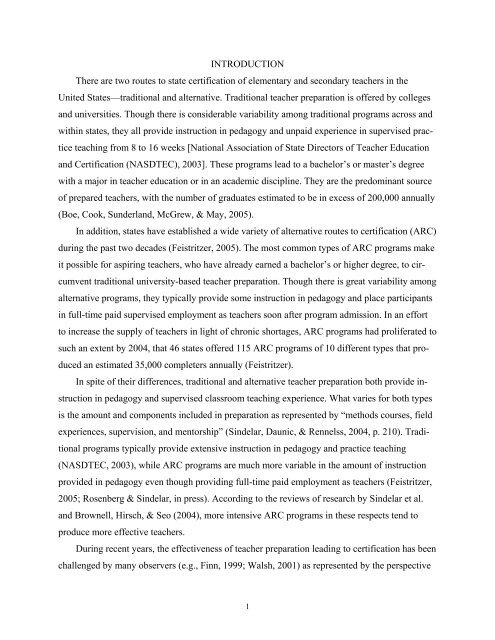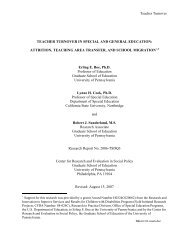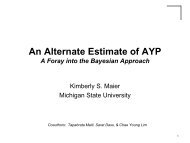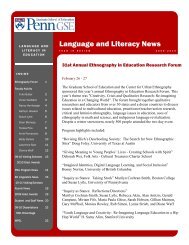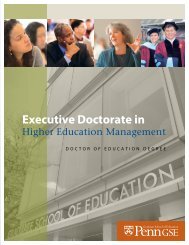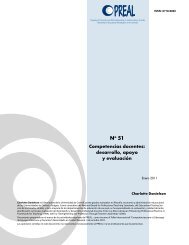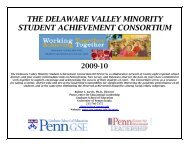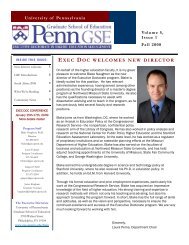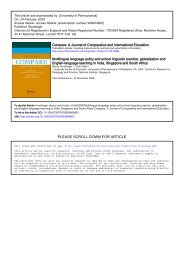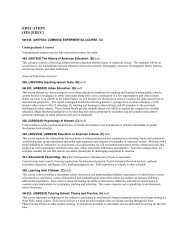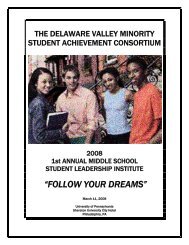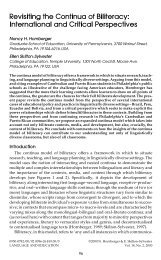does teacher preparation matter for beginning teachers in
does teacher preparation matter for beginning teachers in
does teacher preparation matter for beginning teachers in
Create successful ePaper yourself
Turn your PDF publications into a flip-book with our unique Google optimized e-Paper software.
INTRODUCTION<br />
There are two routes to state certification of elementary and secondary <strong>teacher</strong>s <strong>in</strong> the<br />
United States—traditional and alternative. Traditional <strong>teacher</strong> <strong>preparation</strong> is offered by colleges<br />
and universities. Though there is considerable variability among traditional programs across and<br />
with<strong>in</strong> states, they all provide <strong>in</strong>struction <strong>in</strong> pedagogy and unpaid experience <strong>in</strong> supervised practice<br />
teach<strong>in</strong>g from 8 to 16 weeks [National Association of State Directors of Teacher Education<br />
and Certification (NASDTEC), 2003]. These programs lead to a bachelor’s or master’s degree<br />
with a major <strong>in</strong> <strong>teacher</strong> education or <strong>in</strong> an academic discipl<strong>in</strong>e. They are the predom<strong>in</strong>ant source<br />
of prepared <strong>teacher</strong>s, with the number of graduates estimated to be <strong>in</strong> excess of 200,000 annually<br />
(Boe, Cook, Sunderland, McGrew, & May, 2005).<br />
In addition, states have established a wide variety of alternative routes to certification (ARC)<br />
dur<strong>in</strong>g the past two decades (Feistritzer, 2005). The most common types of ARC programs make<br />
it possible <strong>for</strong> aspir<strong>in</strong>g <strong>teacher</strong>s, who have already earned a bachelor’s or higher degree, to circumvent<br />
traditional university-based <strong>teacher</strong> <strong>preparation</strong>. Though there is great variability among<br />
alternative programs, they typically provide some <strong>in</strong>struction <strong>in</strong> pedagogy and place participants<br />
<strong>in</strong> full-time paid supervised employment as <strong>teacher</strong>s soon after program admission. In an ef<strong>for</strong>t<br />
to <strong>in</strong>crease the supply of <strong>teacher</strong>s <strong>in</strong> light of chronic shortages, ARC programs had proliferated to<br />
such an extent by 2004, that 46 states offered 115 ARC programs of 10 different types that produced<br />
an estimated 35,000 completers annually (Feistritzer).<br />
In spite of their differences, traditional and alternative <strong>teacher</strong> <strong>preparation</strong> both provide <strong>in</strong>struction<br />
<strong>in</strong> pedagogy and supervised classroom teach<strong>in</strong>g experience. What varies <strong>for</strong> both types<br />
is the amount and components <strong>in</strong>cluded <strong>in</strong> <strong>preparation</strong> as represented by “methods courses, field<br />
experiences, supervision, and mentorship” (S<strong>in</strong>delar, Daunic, & Rennelss, 2004, p. 210). Traditional<br />
programs typically provide extensive <strong>in</strong>struction <strong>in</strong> pedagogy and practice teach<strong>in</strong>g<br />
(NASDTEC, 2003), while ARC programs are much more variable <strong>in</strong> the amount of <strong>in</strong>struction<br />
provided <strong>in</strong> pedagogy even though provid<strong>in</strong>g full-time paid employment as <strong>teacher</strong>s (Feistritzer,<br />
2005; Rosenberg & S<strong>in</strong>delar, <strong>in</strong> press). Accord<strong>in</strong>g to the reviews of research by S<strong>in</strong>delar et al.<br />
and Brownell, Hirsch, & Seo (2004), more <strong>in</strong>tensive ARC programs <strong>in</strong> these respects tend to<br />
produce more effective <strong>teacher</strong>s.<br />
Dur<strong>in</strong>g recent years, the effectiveness of <strong>teacher</strong> <strong>preparation</strong> lead<strong>in</strong>g to certification has been<br />
challenged by many observers (e.g., F<strong>in</strong>n, 1999; Walsh, 2001) as represented by the perspective<br />
1


